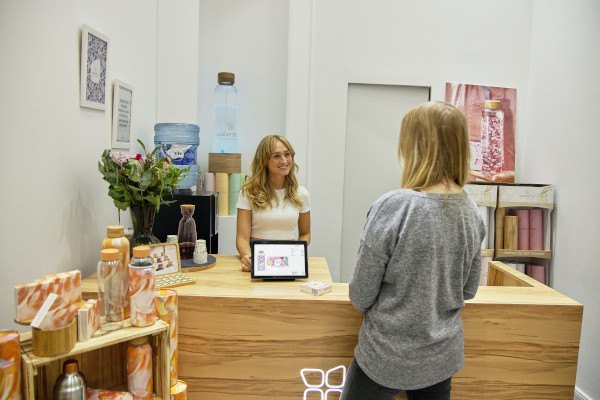Guide to The Shopping Behaviors of Modern Retail Shoppers
What does this Generation want from a retail business? We have all heard about Millennials and their shopping behaviors in retail stores: their wants, needs, and tendencies. This is important because, after all, Millennials make up most of today’s workforce, meaning they make the income to spend in retail. But the next generation, known as Gen Z, is foreseen to significantly impact and influence retail shopping behavior more than their predecessors. It is seen that the Gen Z group will consist of approximately 1.5 million folks bigger in size than the Millennial group. This year alone, it is estimated that about one-third of the US population will be Gen Z. So you can see that a substantial shift in retail is taking place!
Gen Z is best described as people born in 1996 or later. Millennials grew up side-by-side with technology, but Gen Z was born into a heavily digital-centric world around automation and technology. Retailers must be ready to embrace this idea quickly, in order to succeed in a constantly evolving and highly competitive industry,
5 Main Characteristics of Modern Retail Shoppers

They have higher expectations. The expectations from a retailer are more demanding and higher than any other generation. For instance, a Gen Z would easily and not hesitate to walk away when a particular business does not deliver or does not accept card payments. They enjoy and patronize a store that embraces technology the way they do. They look for retailers that make products accessible and easy to test while engaging in human interaction.
They have less patience. They will move on if the expectations are not met or exceeded. Gen Z rarely gives second chances. And when they have a poor experience, they hop on social media to share it.
They are not as price-conscious. While other generations were all about looking for the sweetest “deal, “Gen Z tends to be more about the experience and is willing to pay for it.
They are distracted. Most Gen Z's have more than one device they use daily. They consider themselves huge multi-taskers as they instantly jump from one app to the next. Because this has become their way of life, they do not possess the focus and longer attention span that the previous generations have. This way, they miss key points in a sales presentation and are more challenging to communicate with.
They are influencers. According to a study by Interactions, 70% of parents turn to their Gen Z kids for help in buying decisions. So they are impacting not only their buying decisions but also their family.
Retailers Must Drive The Shopping Experience With Technology

According to a study by Euclid Analytics, despite their technology-based upbringing, the desire for a brick-and-mortar store remains intact for Gen Z. They still prefer to shop in a store versus online. Isn't that great news? However, they expect retailers to utilize technology to drive their shopping experience. Now, they are not asking for robots to assist them; they still want knowledgeable sales experts. In fact, the same study indicated that Gen Zers are more likely to seek out in-store assistance from a salesperson than Millennials. The problem is that the salespeople they come in contact with are often not tech-savvy. They have to turn to Google and social media for advice when this happens. We're saying that while Gen Z wants technology at the center, they're not using it to replace people.
For example, 53% of Gen Z's look for free wifi in the stores they shop, an increase from 41% of Millennials. They want to be able to access coupons and incentives online proactively. With technology, you can offer a coupon or discount to the shopper’s mobile device based on their location in the store. For example, while they’re at the shoe section of your store, they get a sales promotion notification of the season’s shoe notification on their phones via an app.
Improving Your Check Out Process With A POS

Another way technology will shape your retail business is through the efficiency of your checkout process. The foremost reason a Generation Z individual will choose online versus in-store is not having to queue or wait in lines. POS is going to have to become mobile. Retailers have already moved in this direction, eliminating the long, traditional cash wraps and equipping store associates in every department with mobile devices that can take the customer’s payment information as soon as they decide on their purchase. Every smartphone POS operating system has a mobile payment option.
The best investment for retailers will be to improve their POS infrastructure. Gen Z will demand it and choose shops and stores that have it. There are grocery stores with no checkout lanes, for example. The barcode scanners in the store monitor what’s in your basket and charge you for it as you exit the store. Self checkout POS systems are also becoming increasingly popular in retail stores, allowing customers to scan goods themselves and pay without a cashier in a supermarket or other store. Now, retailers have a long time before this is the norm or a demanded expectation, but it is coming.
In-Store Charging Stations
One of the biggest trends in stores used to be creating an area for the kids to play while the parents shop. For Gen Z's, they want charging stations for their devices while they shop. Since these shoppers use their phones so much in the stores, keeping the batteries loaded is essential.
Facebook to Millennial shoppers are instant shopping apps for Gen Z's. Texting leads the way, but apps like Snapchat and Instagram have high usage in-store among these users. This means store design and layout must consider this behavior and adjust. They move and make decisions quickly, so accessories need to be part of the sales body, not the add-ons they have been for other generations.
How About Gen Z and Loyalty Programs?

Do Gen Z shoppers like loyalty programs or are they too erratic for them? The study showed that the usage of loyalty programs were the same for Gen Z as it was for Millennials, meaning that it is just as important. However, this generation requires the loyalty program to be digital, not paper-based. So punch cards, and key ring fobs are out if you want a Gen Z person as part of your loyalty program. You can either give them an app, or, better yet, just let them give you their mobile number as their ID. Many POS systems have already figured this out and have adapted. Loyverse, for example, allows its retailers to award "points" for loyal purchasers. All the customer needs to do is provide their name and a few pieces of information, and they're in.
The Bottomline
The bottom line is that modern shoppers still want a brick and mortar store, but more than ever they want an experience. And if they do not get an experience that exceeds their expectations, they will move on. When asked what they would do if the store they loved closed, the majority said they would find another store, not go online. It's clear they desire an in-store shopping experience. But that experience is going to have technology as the hub. Technology will be the new employee.
Edited by Chooli



0 Comments
Recommended Comments
There are no comments to display.
Please sign in to comment
You will be able to leave a comment after signing in
Sign In Now